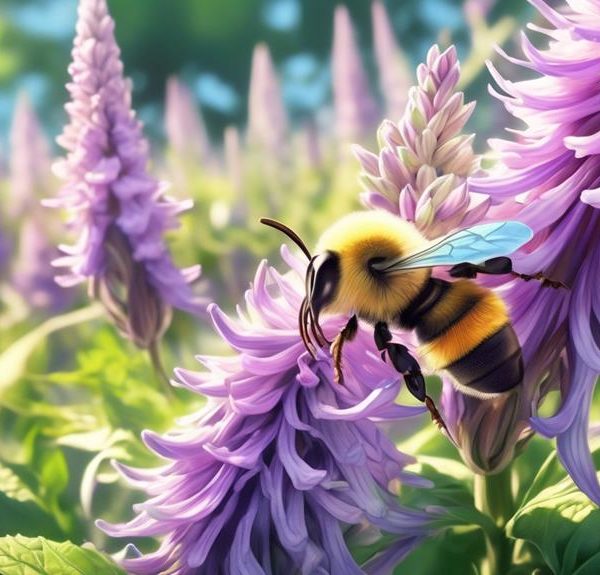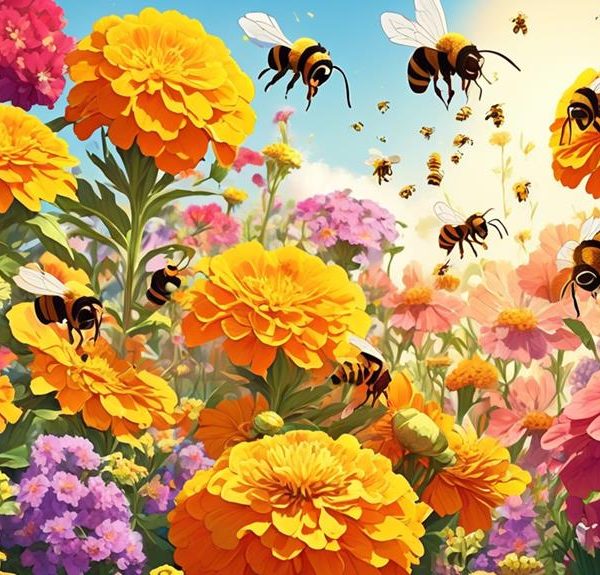Buzz into the world of bees and their intriguing relationship with the Annabelle Hydrangeas, an enigma waiting to be unraveled.
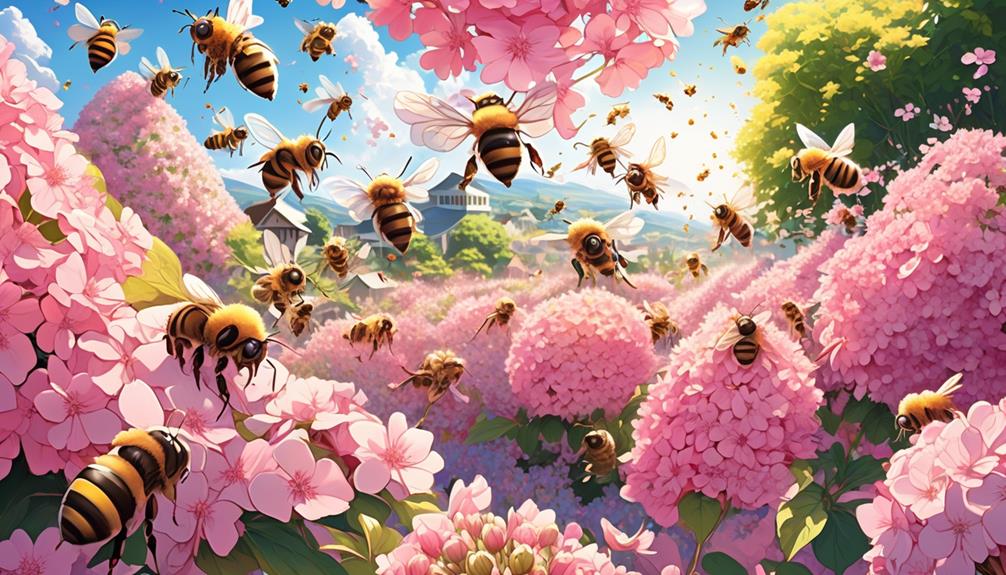
Do Bees Like Annabelle Hydrangeas
Did you know that bees are responsible for pollinating nearly 70% of the world's plants? Among these, the Annabelle Hydrangea has always been a topic of discussion for botanists and bee enthusiasts alike.
You're likely wondering whether these buzzing pollinators hold any particular affinity for these bright, ball-shaped blooms. While it's clear that bees play a crucial role in our ecosystem, their relationship with specific plant species such as the Annabelle Hydrangea is not as straightforward.
Stick around, as we explore this intriguing interaction further.
Key Takeaways
- Bees are essential for pollinating Annabelle Hydrangeas and promoting flower production.
- Annabelle Hydrangeas attract bees with their sweet nectar and visually appealing white flowers.
- By incorporating plant diversity and avoiding pesticides, gardeners can enhance bee attraction in their gardens.
- Bees play a crucial role in improving the health and vigor of Annabelle Hydrangeas through cross-pollination and genetic diversity.
Understanding Annabelle Hydrangeas
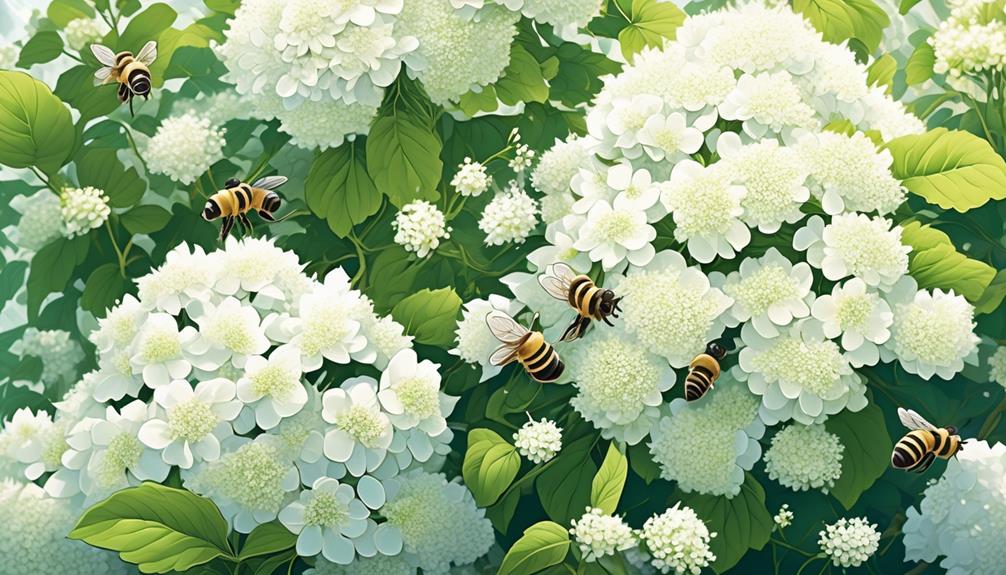
To fully appreciate the charm of Annabelle Hydrangeas, you need to delve into their distinguishing features and understand their unique growing conditions. These plants are part of the Hydrangea arborescens species, native to the eastern United States. They're renowned for their large, round, white blooms that appear from midsummer to fall, making them a star attraction in any garden.
It's crucial to note that Annabelle Hydrangeas thrive in hardiness zones 3-9. They require well-drained, moist soil with a slightly acidic pH. You need to plant them where they'll receive morning sun and afternoon shade, as too much direct sunlight can scorch the leaves.
You'll find that these hydrangeas have a deciduous nature, meaning they lose their leaves annually. They're also known for their remarkable bloom cycle. Unlike many hydrangeas, Annabelles bloom on new wood, allowing them to withstand harsh winters and still produce stunning flowers come summertime.
Understandably, you're not just planting Annabelle Hydrangeas for their aesthetic appeal. They're also a favourite among bees, providing a valuable nectar source. This makes them an excellent addition if you're looking to create a pollinator-friendly garden.
The Importance of Bees in Pollination
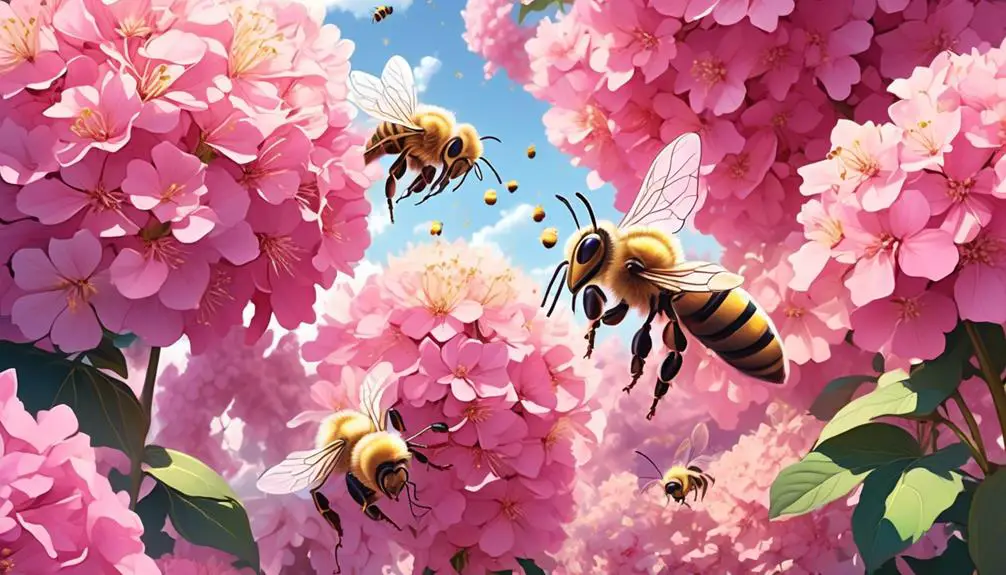
Understanding the critical role bees play in pollination not only enriches your gardening knowledge, but it's also vital for the survival and prosperity of your Annabelle Hydrangeas. Bees are the primary pollinators in most ecosystems, responsible for about 70% of all plant pollination. They're nature's little helpers, transferring pollen from the male anthers of a flower to the female stigma.
In the specific case of your Annabelle Hydrangeas, pollination is key to flower production. When bees visit these hydrangeas, pollen adheres to their bodies. As they move from flower to flower, they deposit some of this pollen, enabling fertilization and the production of seeds.
However, it's not just about the flowers. Bees also significantly contribute to the overall health of the plant. This pollination process allows for genetic diversity, strengthening the plant's resilience to pests, diseases, and environmental changes. Furthermore, it promotes plant growth and fruit development, ensuring the vibrancy and longevity of your hydrangeas.
Bees' Attraction to Annabelle Hydrangeas
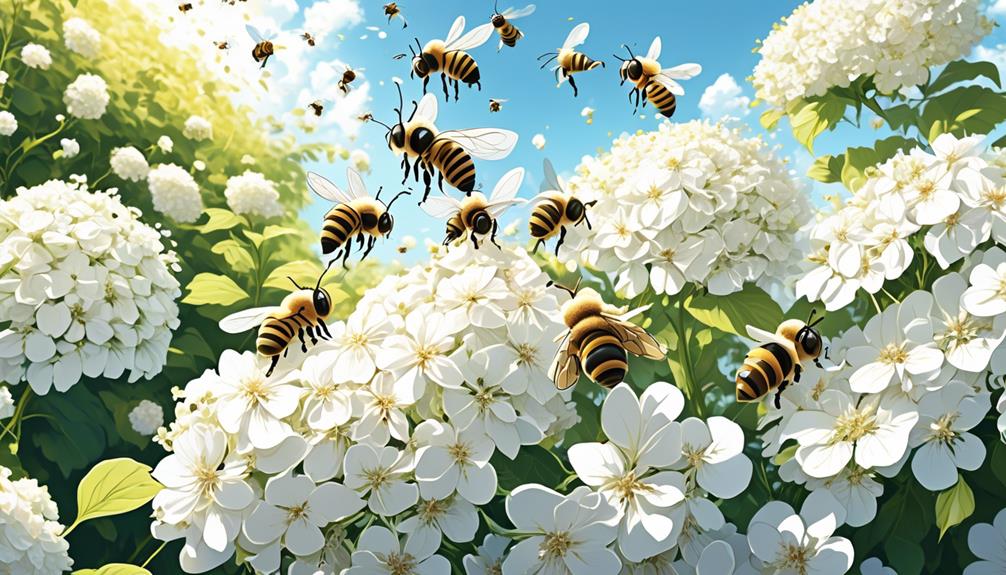
Attracted by the large, white blooms, bees find Annabelle Hydrangeas irresistible, making these plants a buzzing hotspot in your garden. This attraction isn't accidental; it's a result of the plant's strategic survival tactic.
The Annabelle Hydrangea, scientifically known as Hydrangea arborescens, is a species of flowering plant native to North America. It's characterized by its large, circular clusters of white flowers, each cluster containing hundreds of individual blossoms. That's a lot of potential nectar for bees!
What's fascinating is how these hydrangeas attract bees. They produce a sweet, fragrant nectar that bees find hard to resist. But it's not just the nectar that attracts bees. The white color of the flowers acts as a visual beacon, drawing bees in from afar. This combination of sensory appeal makes Annabelle Hydrangeas a favorite among pollinators.
But why do the hydrangeas want to attract bees? It's all about reproduction. Bees moving from flower to flower carry pollen, aiding in the cross-pollination process. This ensures the survival and propagation of the plant species. So, by attracting bees, Annabelle Hydrangeas secure their own survival. It's a symbiotic relationship that benefits both parties.
Improving Bee Attraction in Your Garden
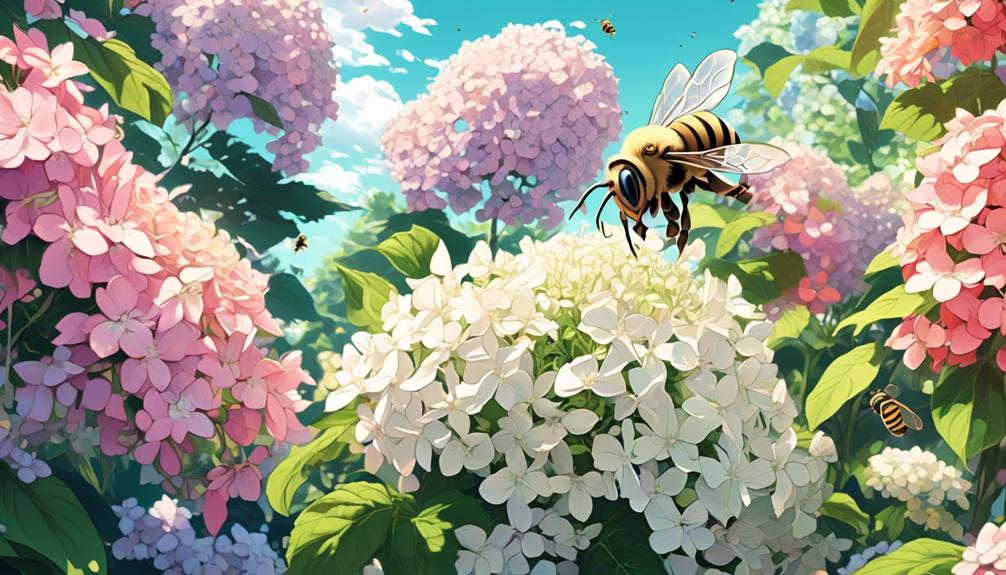
Now that we've explored why bees are drawn to the Annabelle Hydrangeas, let's focus on how you can enhance your garden to further attract these beneficial pollinators. It's more straightforward than you might think, and the results can be incredibly rewarding.
Here's a simple table with two key strategies:
Strategy | Explanation |
|---|---|
Plant Diversity | Bees are attracted to a wide range of flowering plants. Incorporate various species, colors, and shapes to increase your garden's appeal. |
Pesticide-Free | Chemicals can harm bees. Stick to organic gardening practices and natural pest control methods. |
Implementing these strategies won't just attract more bees; it'll also promote a healthier ecosystem in your garden.
Remember, diversity is crucial. Bees are drawn to different types of flowers. They're particularly fond of single flowering plants and those that bloom in clusters, like the Annabelle Hydrangea. Opt for native plants when possible, as these are likely to be most appealing to local bee populations.
Avoiding pesticides is equally vital. They're harmful to bees and can disrupt their foraging patterns. Instead, try introducing beneficial insects or using other natural pest control methods. With these steps, your garden will be buzzing with activity in no time.
Effects of Bees on Hydrangea Health
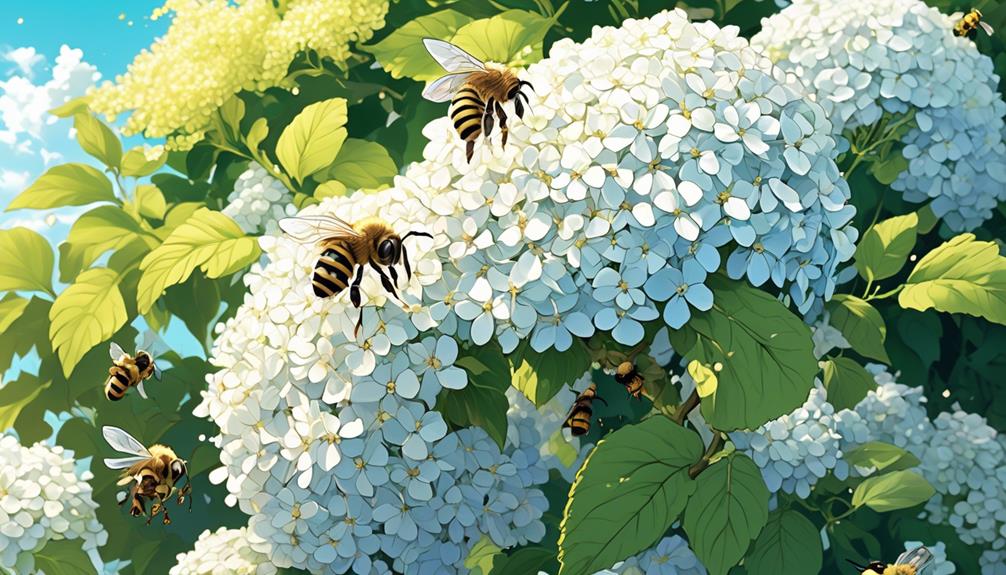
While you may already appreciate the visual charm bees bring to your hydrangea garden, you mightn't be aware of the significant health benefits these industrious pollinators provide to your blooms. Bees, crucial for plant reproduction, facilitate the process of cross-pollination, ensuring genetic diversity in your hydrangeas. This diversity bolsters the plants' resistance to diseases and pests, enhancing overall health and longevity.
When bees collect nectar and pollen from your hydrangeas, they inadvertently transfer pollen from the male parts of a flower to the female parts of another. This leads to fertilization and the production of seeds, ensuring the continuation of your hydrangea plants. Without bees' intervention, your hydrangeas might struggle to reproduce, resulting in fewer blooms in subsequent seasons.
Moreover, bees' pollination activity increases the vigor of your hydrangeas. This can lead to larger, more vibrant flowers and foliage, improving the overall aesthetic appeal of your garden.
Therefore, the seemingly simple act of bees buzzing around your hydrangeas isn't just a delightful sight, it's a vital part of maintaining the health and beauty of your plants. So, next time you spot a bee, remember, it's not just visiting—it's working to enrich your garden.
Frequently Asked Questions
What Other Types of Plants Do Bees Typically Prefer?
Aside from hydrangeas, you'll find bees are also attracted to a variety of other plants. They're particularly fond of lavender, echinacea, and sunflowers due to their bright colors and nectar.
Basil, sage, and other herbs are also bee favorites. Fruit trees, especially apple and cherry, draw bees in with their fragrant blossoms.
How Can I Protect My Bees From Pesticides or Other Harmful Substances?
You're right to be concerned about protecting your bees from harmful substances. Instead of using chemical pesticides, opt for natural alternatives whenever you can.
Plant bee-friendly flora to encourage their foraging. Always provide clean water sources and remember, if you're treating your plants, do it in late evening when bees aren't active.
Ultimately, promoting a healthy, diverse ecosystem is the best way to safeguard your bees.
How Long Does It Take for Bees to Pollinate Annabelle Hydrangeas?
You're curious about how long it takes for bees to pollinate Annabelle Hydrangeas. Well, it's not a simple answer. It depends on several factors, including the number of bees visiting the blooms and weather conditions.
However, it typically takes a few days to a week for bees to sufficiently pollinate these flowers. Remember, bees' pollination habits can alter due to variations in temperature, rain, and other environmental aspects.
Are There Other Insects That Can Help Pollinate Annabelle Hydrangeas?
Yes, other insects can certainly aid in pollinating Annabelle Hydrangeas. Butterflies, moths, and even certain beetles often visit these flowers. While they're not as efficient as bees, they can transport pollen from flower to flower.
However, it's important to remember that bees are the primary pollinators. So, while other insects contribute, bees are still vital for the success of your Annabelle Hydrangeas.
How Can I Safely Remove a Beehive From My Garden Without Harming the Bees?
To safely remove a beehive from your garden without harming the bees, you'll need professional assistance. Don't attempt it alone, as bees can become aggressive.
Contact a local beekeeper or pest control service who use humane methods. They'll typically relocate the hive to a place where bees can thrive.
Conclusion
So, do bees like Annabelle hydrangeas?
Absolutely! They're attracted to the blooms' sweet scent and abundance of nectar. These busy pollinators play a vital role in your garden's health, and attracting them can improve your hydrangeas' bloom.
Remember, a bee-friendly garden is a healthy garden. Your Annabelle hydrangeas won't just look better, they'll thrive, thanks to these tiny, industrious workers.
Next time you spot a bee buzzing around your hydrangeas, be sure to thank it!

